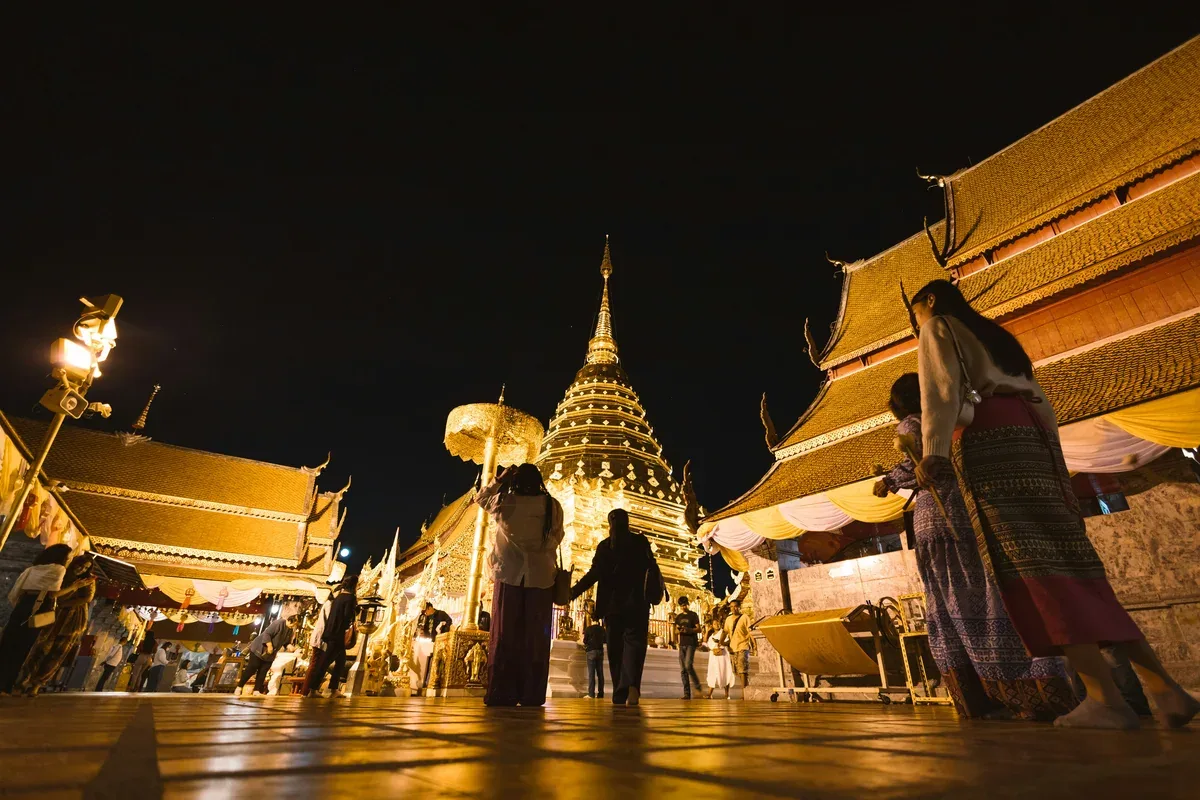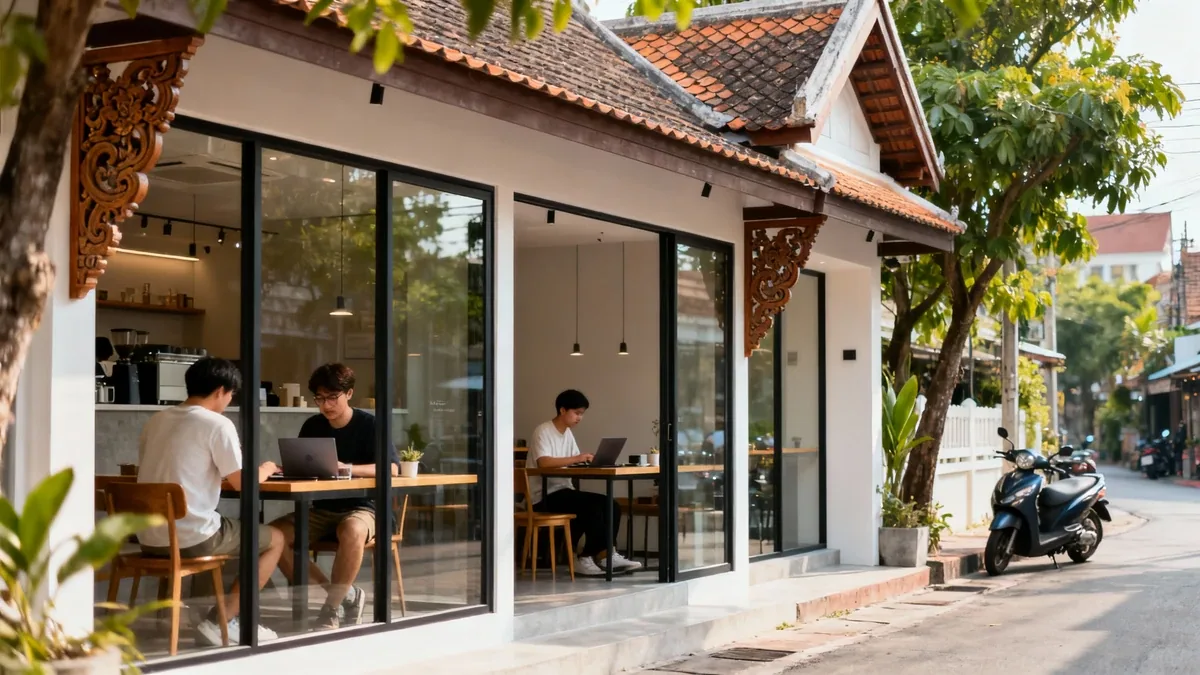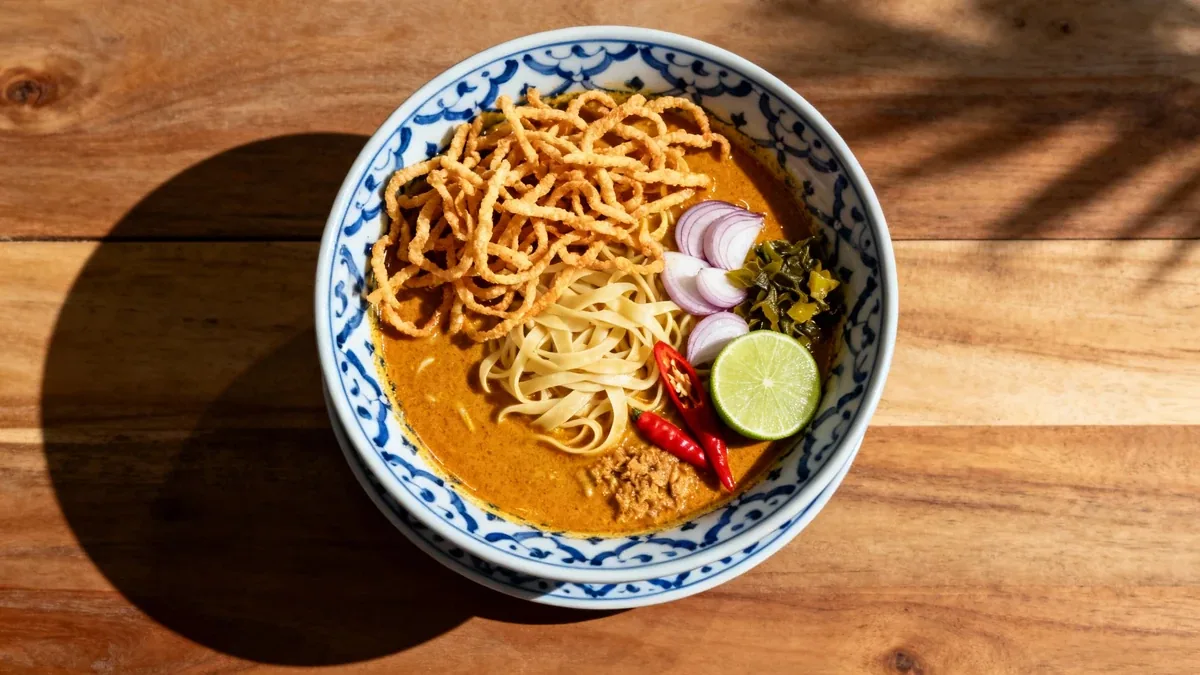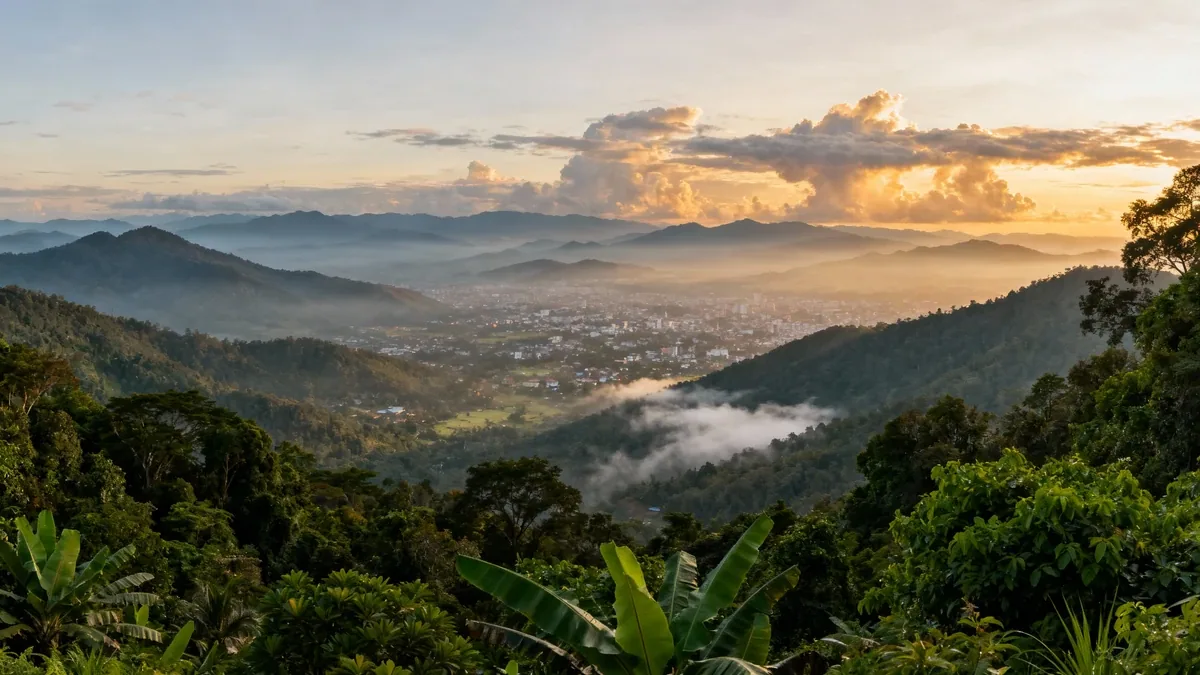
🌄Chiang Mai
Northern Thailand's cultural gem

Northern Thailand's cultural gem
Picture this: You're sitting in a minimalist cafe, laptop open, third-wave coffee steaming beside you. Through floor-to-ceiling windows, you watch saffron-robed monks walk past ancient temple walls while a scooter piled impossibly high with rambutan fruit navigates the narrow soi. Your rent is less than you'd pay for a parking space back home. This is Tuesday morning in Chiang Mai—and it's why this Northern Thai city has quietly become the global capital of the digital nomad lifestyle.
Nestled in a mountain valley 700 kilometers north of Bangkok, Chiang Mai feels like a different Thailand altogether. Gone is the frenetic energy of the capital, replaced by something slower, more thoughtful, more deeply rooted in Lanna culture. The city's 1.2 million residents live surrounded by over 300 Buddhist temples, misty mountains, and a creative energy that attracts artists, entrepreneurs, and remote workers from every corner of the globe.
What draws people here isn't just the legendary cost of living—though living well on 30,000-50,000 THB monthly certainly helps. It's the alchemy of affordability meeting authenticity, of reliable infrastructure coexisting with genuine Thai culture, of being able to work from world-class co-working spaces in the morning and hike jungle trails to hidden waterfalls in the afternoon. Chiang Mai has mastered the art of being exactly what remote workers need without losing its soul in the process.
"Chiang Mai has mastered the art of being exactly what remote workers need without losing its soul in the process."
Where you live in Chiang Mai shapes your entire experience. This isn't a massive city where neighborhoods blur together—it's compact enough that your choice of area determines your daily rhythms, your social circle, even your relationship with Thai culture itself.
Nimman (Nimmanhaemin) has become synonymous with digital nomad life. Walk down Nimmanhaemin Road on any weekday afternoon and you'll pass dozens of people hunched over MacBooks in air-conditioned cafes, wearing noise-canceling headphones and sipping iced Americanos. This is ground zero for the laptop lifestyle. Every third storefront is either a co-working space, a trendy cafe, a boutique hotel, or a restaurant serving perfect pad krapow next door to authentic Neapolitan pizza. Maya Mall anchors one end with its cinemas and food courts, while narrow sois branch off packed with massage shops, yoga studios, and minimalist cocktail bars.
The convenience is undeniable—everything you need within walking distance, fast wifi everywhere, English spoken widely. But Nimman's success has brought density. Rent has climbed to 8,000-20,000 THB for modern studios and one-bedrooms. The neighborhood can feel like an expat bubble where you could theoretically spend weeks without speaking Thai or eating genuinely local food. Some people love this; others find it's exactly what they came to Thailand to avoid.

The Old City offers the antidote. Surrounded by ancient walls and a moat that forms a perfect square, this historic heart beats to a more traditional rhythm. Temples occupy nearly every corner—Wat Phra Singh with its glittering Lanna-style bot, Wat Chedi Luang with its massive ruined stupa, dozens more tucked down quiet lanes. Sunday evenings transform Ratchadamnoen Road into the famous Walking Street market, where half the city turns out to browse handicrafts and eat from endless food stalls.
Living inside the square walls means embracing a slower pace. More guesthouses than modern condos, more local restaurants than international chains, more motorbikes than cars. Rent runs cheaper—6,000-15,000 THB for charming apartments, often in converted traditional houses. You'll hear temple bells at dawn, smell incense wafting from spirit houses, navigate around monks on morning alms rounds. This is Chiang Mai as it's been for centuries, still alive amid the tourist traffic.
Santitham attracts those seeking the middle path—accessible but not touristy, local but not isolated. This residential area northeast of the Old City has quietly become popular with long-term expats and families who want space without sacrificing convenience. The vibe is distinctly more Thai: street food vendors set up every evening, neighborhood markets bustle with locals buying vegetables and fresh-killed chicken, parks fill with people exercising and socializing.
Santitham offers the best value for space—7,000-16,000 THB typically gets you larger apartments, sometimes whole townhouses. The trade-off is fewer western amenities and more reliance on local infrastructure. Your neighbors will be Thai families, not German freelancers. Conversations happen in broken Thai-English hybrids. It's perfect if you want to actually live in Thailand rather than in a Thailand-themed expat enclave.
Riverside and the Ping River areas appeal to those drawn to water and a quieter aesthetic. The Ping River winds through Chiang Mai's eastern edge, and the neighborhoods along its banks have developed a distinct character—more boutique hotels than big apartment blocks, more organic cafes than convenience stores, more bicycles than scooters. Mornings here start with joggers along the riverside path and yoga sessions in garden cafes. The pace feels unhurried, almost meditative.
Expect to pay 8,000-18,000 THB for apartments with character—exposed brick, high ceilings, river views if you're lucky. You're slightly removed from the action, which is precisely the appeal. Easy to reach everything by bike, far enough away to feel like you're in a different city when you close your door at night. For more insights on finding the right neighborhood in Thailand, our comprehensive housing guides can help you navigate the search.
Start your search online: Facebook groups like "Chiang Mai Condos and Apartments for Rent" and "Chiang Mai Housing" post hundreds of listings weekly. Many landlords prefer renting directly through these groups to avoid agency fees.
Visit in person: Once in Chiang Mai, walk your target neighborhood looking for "For Rent" signs (often only in Thai). Ask at cafes and co-working spaces—word-of-mouth leads to the best deals.
Negotiate and inspect: Monthly rates are negotiable, especially for 6+ month leases. Always inspect thoroughly—test the A/C, check water pressure, verify the wifi speed (essential for remote work). Most landlords require one month deposit plus one month advance rent.

Numbers tell part of the story. A comfortable life in Chiang Mai—modern apartment, regular western food, gym membership, occasional weekend trips—runs 35,000-45,000 THB monthly for a single person. That's roughly $1,000-1,300 USD. You can go lower by embracing local lifestyle: eat mostly Thai food, rent a basic place, skip the co-working membership. Some manage on 20,000-25,000 THB, though that requires discipline and accepting a more local standard of living.
But the real value isn't captured in spreadsheets. It's in being able to get excellent Thai massages three times a week without thinking about the cost (200-300 THB each). It's fresh smoothies for breakfast (60 THB), incredible street food dinners (80-150 THB), craft coffee that would cost $8 in San Francisco for 100 THB here. It's the mental freedom of knowing that unexpected expenses—emergency dental work, replacing a broken laptop, flying home for a family event—won't devastate your finances.
This budget assumes a mix of local and western lifestyle. You can reduce costs significantly by eating primarily Thai food and choosing local housing options.
Chiang Mai didn't accidentally become the digital nomad capital—it cultivated the infrastructure deliberately. Co-working spaces here pioneered the concept before it went global. Punspace opened in 2013 and remains beloved for its three locations, reliable wifi (200+ Mbps fiber), ergonomic setups, and monthly memberships around 2,500-3,500 THB. CAMP draws the startup crowd with its slick industrial design and regular networking events. Yellow attracts the creative class—designers, writers, photographers—with its chill rooftop vibe. Alt_Chiang Mai goes upscale with standing desks, meeting pods, and a bar on the top floor.
But honestly, the co-working spaces are almost redundant because the cafe culture is so dialed in. Owners understand exactly what laptop workers need: fast wifi (they post the speed on chalkboards), abundant power outlets, comfortable seating you can occupy for hours, and good coffee at prices that don't punish you for ordering three cups during a long work session. Ristr8to roasts their own beans and serves some of Thailand's best espresso. Graph Cafe offers minimalist Japanese-inspired spaces perfect for focused work. Akha Ama showcases coffee from Northern Thailand's hill tribes while providing arguably the best work atmosphere in the city.
The social infrastructure is equally developed. Facebook groups coordinate daily events: Muay Thai classes at 6am, hiking trips on weekends, language exchanges Tuesday evenings, startup meetups monthly, volleyball games Thursday afternoons. The community is remarkably welcoming—show up alone to any event and you'll leave with dinner plans. There's a built-in understanding that most people here are solo travelers or digital workers figuring out remote life, which creates unusual openness.
March through April brings the infamous burning season—when farmers across Northern Thailand and neighboring countries burn agricultural fields, creating a thick smoke haze that blankets the region. Air quality becomes hazardous, visibility drops dramatically, and the pollution levels regularly exceed safe limits. Many digital nomads plan their year around this, leaving Chiang Mai for these months. It's not a minor inconvenience—it's a serious quality of life and health issue that you need to factor into any long-term plans.
Northern Thai cuisine differs markedly from what most people know as "Thai food." Lanna culture brings its own flavors—less coconut milk and seafood, more herbs and fresh vegetables, complex chili pastes called nam prik, sticky rice as the staple rather than steamed jasmine. Khao soi, the region's signature dish, combines flat egg noodles in curry soup with crispy fried noodles on top—comfort food that defines Chiang Mai for many expats. Sai oua, the local herbal sausage, appears at every market. Larb kua, a warm minced meat salad, tastes nothing like the Isaan version served elsewhere.
You can eat these dishes for 40-80 THB at local restaurants and street stalls throughout the city. Morning markets like Somphet sell fresh ingredients and prepared foods at prices that make cooking feel inefficient. The Sunday Walking Street becomes a food paradise with hundreds of vendors selling everything from grilled sausages to mango sticky rice to experimental fusion creations.
But Chiang Mai also caters to homesick expats and food-obsessed travelers with unexpected sophistication. You'll find excellent Italian (La Bottega del Buongustaio), outstanding Japanese (Osaka Restaurant), proper French bakeries (Mont Blanc), authentic Mexican (Miguel's), solid Indian (Taste from Heaven for vegetarian, Mayfair for north Indian curries), even good pizza (Duke's). Prices sit far below Bangkok—a quality dinner with wine runs 500-800 THB rather than 1,500-2,000.

Chiang Mai's cool season (November through February) is genuinely cool—morning temperatures around 15°C that require a light jacket, comfortable days at 25-28°C perfect for walking and outdoor activities. This is Thailand at its absolute best, the weather that makes you understand why people rhapsodize about the country. Locals break out sweaters. Tourists photograph themselves in scarves. Everyone spends as much time outside as possible because these months are precious.
Then comes March and everything shifts. The hot season arrives with temperatures climbing to 35-40°C, the air thick and still. This alone wouldn't be terrible—Bangkok manages similar heat—but March and April bring the burning season. Agricultural fires across Northern Thailand, Myanmar, and Laos create a smoke haze so thick that the mountains disappear, the sun turns orange, and the AQI (Air Quality Index) regularly hits 200-300, well into hazardous territory. Schools close. People wear N95 masks outdoors. The expat community largely evacuates, heading to the islands, to Bangkok, home for a few months, anywhere with breathable air.
The rainy season (June through October) brings relief—cooler temperatures, dramatically improved air quality, afternoon thunderstorms that clear the heat and water the mountains. The rains are manageable, usually concentrated in afternoon downpours rather than all-day drizzle. Everything turns green, waterfalls flow strong, the city feels washed clean. Many long-term residents consider this second-best season after the cool months, preferring it to the oppressive heat and smoke of March-May.
"These four months of cool season perfection are what keep people returning to Chiang Mai year after year, planning their lives around being here when the mountains are clear and the mornings are crisp."
Chiang Mai's private hospitals operate at a level that surprises first-time visitors. Bangkok Hospital Chiang Mai and Chiang Mai Ram both offer international-standard care with English-speaking doctors, many trained overseas. You can walk in without an appointment, see a doctor within 30 minutes, and pay 500-1,500 THB for the consultation. Prescriptions are filled on-site. The whole experience—from walking in the door to walking out with medication—takes less time than scheduling an appointment would back home.
Dental care is similarly accessible and affordable. Root canals that cost $1,500 in the US run 8,000-12,000 THB here. Cleaning and checkups: 800-1,500 THB. Many digital nomads time dental work to their Chiang Mai stays. Dental clinics advertise in English, show international certifications, and welcome medical tourists alongside expat residents. For comprehensive information about Thailand's healthcare system, our guides cover everything from choosing hospitals to understanding insurance options.
Most expats rent scooters within a week of arriving. It's almost a rite of passage—negotiating a monthly rental (2,000-3,500 THB), getting used to driving on the left, learning the unwritten rules of Chiang Mai traffic (which is mercifully light compared to Bangkok). The city is small enough that nowhere takes more than 15 minutes by scooter. Parking is easy. Gas costs almost nothing. The freedom is intoxicating—being able to explore mountain roads, reach hidden temples, chase down rumors of excellent khao soi in some far neighborhood.
For those avoiding scooters, songthaews (red pickup trucks with bench seats) cover most routes for 30-60 THB shared rides, more if you charter one. Grab works reliably for longer distances at 60-150 THB across town. The Old City is entirely walkable, as is Nimman once you're in the neighborhood. Many expats get by on a combination of walking, occasional Grab rides, and rented scooters for weekend adventures.
Chiang Mai's digital nomad popularity predates Thailand having official visa options for remote workers. For years, people cycled through tourist visas, education visas, and border runs. The 2024 introduction of the Digital Nomad Visa (DTV) changed the game—offering 180 days per entry on a 5-year multiple-entry visa for those who qualify. Retirement visas work for those over 50 with the financial means. Elite Visa remains an option for those willing to pay 600,000-2,000,000 THB for long-term guaranteed stays.
Immigration enforcement varies, but the basic reality is that you need a legal visa strategy for any extended stay. The Chiang Mai expat community shares extensive knowledge about visa options, border run logistics, and immigration office procedures. Facebook groups maintain updated guides. Co-working spaces host occasional visa information sessions. The infrastructure exists to help you figure it out, but it's on you to stay legal.
People fall in love with Chiang Mai for the lifestyle it enables—working remotely while living well on modest income, being surrounded by nature and culture, building community with like-minded people from around the world. The city has perfected the infrastructure for this life: reliable internet, comfortable workspaces, affordable everything, enough international amenities to prevent culture shock, enough Thai authenticity to feel like you're actually in Thailand.
But the limitations are real. Career opportunities for local employment barely exist outside teaching English or working in tourism. The city is small—you'll run into the same people repeatedly, exhaust the restaurant scene, feel like you've seen everything. The pollution season drives many away permanently. Some find the digital nomad scene too transient, too superficial, everyone passing through for a few months rather than building real roots. The bubble can feel stifling.
Chiang Mai works best as a base rather than a permanent home for most people. Spend the cool season here (November to February), leave during burning season, return for the green season if you love it. Use it as a hub for exploring Southeast Asia. Test it for a few months before committing to a year. The city rewards those who embrace its rhythms rather than fight them—who accept that some months are perfect and others require escape, who appreciate what's here rather than lamenting what isn't, who find the balance between expat convenience and Thai authenticity that fits their needs.

For those starting their Thailand journey, Chiang Mai offers an easier entry point than Bangkok's overwhelming intensity or the islands' limited infrastructure. The community welcomes newcomers, the costs allow experimentation, the pace permits adjustment. You can work productively, live well, explore authentically, and save money—a combination that's increasingly rare in today's world. Just respect the burning season warnings, plan your calendar accordingly, and give yourself permission to leave when the city's limitations outweigh its charms. For many, though, those perfect cool season mornings—crisp mountain air, temple bells in the distance, excellent coffee in hand, the day's work ahead—are reason enough to keep coming back.
Population
1.2 MILLION
Average Rent
8,000-18,000 THB
Monthly Budget
30,000-50,000 THB
Temperature
15-35°C
Expat Population
40,000+
Best For
Digital nomads, remote workers, retirees
Quick Take
Chiang Mai is ideal for remote workers and those seeking affordability without sacrificing quality. Perfect cool-season weather and amazing community, but be prepared for burning season air quality issues and a smaller city feel.
Cool Season
Nov-Feb · Perfect weather, festivals, peak tourism
Hot/Burning Season
Mar-May · Avoid if possible due to air pollution
Rainy Season
Jun-Oct · Green scenery, fewer tourists, good air quality
→ Chiang Mai Digital Nomads (Facebook)
→ Chiang Mai Expats (Facebook)
→ Punspace, CAMP, Yellow (co-working)
→ Bangkok Hospital Chiang Mai
→ Chiang Mai Immigration Office